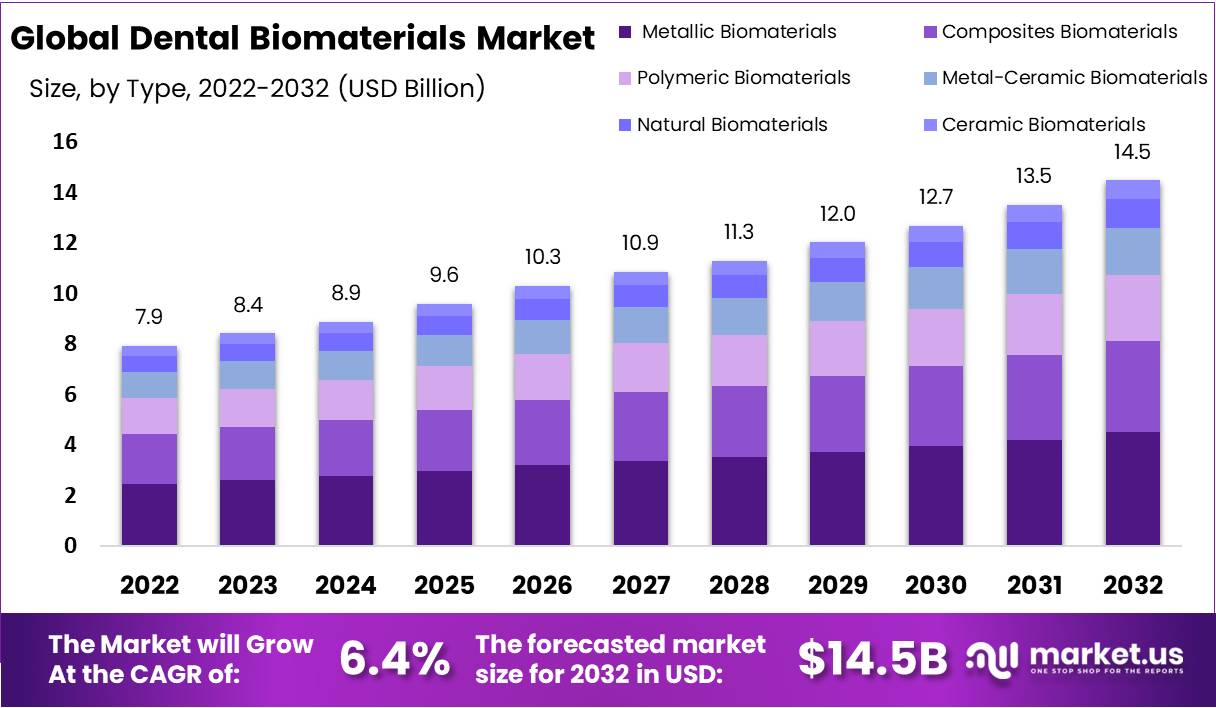Introduction
The Dental Biomaterials Market is projected to expand significantly, with its valuation expected to rise from USD 9.5 billion in 2023 to around USD 19.6 billion by 2033, achieving a Compound Annual Growth Rate (CAGR) of 7.5% throughout the forecast period from 2024 to 2033. This growth is primarily fueled by the adoption of advanced biomaterials in dental care. Notably, materials such as titanium niobium (TiNb) and titanium dioxide nanotubes (TNTs) are gaining traction due to their enhanced mechanical properties like increased toughness and corrosion resistance. These materials facilitate osseointegration, where dental implants effectively anchor to bone tissue, improving both the functionality and biocompatibility of dental solutions.
Innovations in surface modification technologies also contribute to the sector’s growth. Techniques such as plasma immersion ion implantation are revolutionizing dental implant surgeries by enhancing the bioactivity and mechanical attributes of implant surfaces. This method not only ensures a uniform treatment application across complex geometries but also offers significant reductions in cost and processing time, benefiting the mass production of dental implants. The incorporation of these technologies is transforming patient outcomes by providing more durable and effective dental treatments.
The sector’s development is supported by a robust research framework that integrates interdisciplinary collaboration across clinical, academic, and research domains. This collaboration is essential for transitioning theoretical research into practical clinical applications, ensuring the introduction of innovative materials and technologies that are both effective and safe for patient care. By fostering partnerships among clinicians, researchers, and students, the industry is positioned to maintain a continuous pipeline of technological advancements that enhance dental care quality.
In response to these advancements, the industry is actively updating clinical practice guidelines to incorporate the latest scientific discoveries. These updated guidelines are crucial for standardizing dental care and ensuring the ethical and effective utilization of new biomaterials within dental practices. By aligning clinical practices with cutting-edge research, the sector not only improves patient care but also ensures that dental professionals are well-equipped to apply the most recent innovations in their practices.
Overall, the Dental Biomaterials Market is poised for substantial growth driven by technological advancements and a strong commitment to research and clinical collaboration. As the sector continues to innovate, it remains at the forefront of enhancing dental care, promising improved outcomes for patients through the use of advanced materials and technologies.

Key Takeaways
- In 2023, the Dental Biomaterials Market achieved revenues of USD 9.5 billion, anticipated to climb to USD 19.6 billion by 2033.
- The market grew at a CAGR of 7.5% during the observed period.
- Type segmentation shows metallic biomaterials leading with a 51.2% market share in 2023.
- Within applications, orthodontics claimed a significant portion, representing 41.6% of the market.
- Dental laboratories, as end-users, dominated the market with a 41.5% revenue share.
- North America held the largest market share regionally, at 38.9% in 2023.
Regional Analysis
- Tissue Regeneration: The advancement in dental biomaterials has revolutionized tissue regeneration. These materials are now integral in rebuilding various dental structures, including enamel, dentin, and the alveolar bone. They are primarily used in scaffolds that facilitate the growth of new tissues while ensuring proper healing. This approach not only accelerates recovery but also enhances the overall effectiveness of regenerative treatments in dentistry.
- Orthodontics: In orthodontics, biomaterials play a crucial role in improving the outcomes of braces and other devices designed to correct dental alignment. These materials assist in the controlled movement of teeth and help stabilize them post-treatment, making orthodontic interventions more efficient and effective over time.
- Periodontal Treatment: Biomaterials are increasingly utilized in the treatment of periodontal diseases. Developers are focusing on materials that can deliver therapeutic agents directly to the affected areas. Additionally, the incorporation of antibacterial properties into these materials helps combat infections directly at the source, enhancing the efficacy of periodontal therapies.
- Implantology: The domain of dental implants heavily relies on biomaterials, especially those that improve the integration of implants with the jawbone, known as osseointegration. These materials are vital for ensuring the long-term stability and durability of dental implants, addressing both functional needs and patient comfort.
- Aesthetic Dentistry: Aesthetic concerns in dentistry are addressed through biomaterials that merge strength with visual appeal. These are particularly valuable in front tooth restorations, where the appearance is as important as functionality. By using advanced biomaterials, dental professionals can achieve restorations that are not only durable and functional but also visually indistinguishable from natural teeth.
Emerging Trends
- Regenerative Biomaterials: The development of biomaterials that restore and regenerate dental structures is gaining momentum. These materials are designed to mimic the properties of natural dental tissues, thereby supporting and enhancing the body’s natural healing processes. This approach not only improves functional outcomes but also contributes to longer-lasting dental repairs.
- Nanotechnology in Dentistry: Nanotechnology is making significant strides in the dental sector. Nanomaterials are being incorporated into dental composites to enhance their mechanical properties, durability, and aesthetic appeal. This technology ensures that dental restorations are not only more durable but also more visually appealing to patients.
- Integration of Digital Dentistry: Digital technologies are becoming increasingly essential in dental biomaterials. Tools such as CAD/CAM systems and 3D printing are revolutionizing the design and fabrication of dental restorations. These technologies enable high precision and customization in dental treatments, leading to better patient outcomes.
- Bioactive Materials: There is growing interest in bioactive dental materials. These composites are engineered to release substances that aid in the regeneration of dental tissues and help combat oral diseases. Their use is pivotal in preventing further dental decay and promoting overall oral health.
- Customization through Additive Manufacturing: Additive manufacturing, including 3D printing, is transforming the production of dental implants and scaffolds. This technology allows for the creation of highly customized dental products tailored to individual patient needs, enhancing the effectiveness and comfort of dental treatments.
Use Cases
- Tissue Regeneration: The advancement in dental biomaterials has revolutionized tissue regeneration. These materials are now integral in rebuilding various dental structures, including enamel, dentin, and the alveolar bone. They are primarily used in scaffolds that facilitate the growth of new tissues while ensuring proper healing. This approach not only accelerates recovery but also enhances the overall effectiveness of regenerative treatments in dentistry.
- Orthodontics: In orthodontics, biomaterials play a crucial role in improving the outcomes of braces and other devices designed to correct dental alignment. These materials assist in the controlled movement of teeth and help stabilize them post-treatment, making orthodontic interventions more efficient and effective over time.
- Periodontal Treatment: Biomaterials are increasingly utilized in the treatment of periodontal diseases. Developers are focusing on materials that can deliver therapeutic agents directly to the affected areas. Additionally, the incorporation of antibacterial properties into these materials helps combat infections directly at the source, enhancing the efficacy of periodontal therapies.
- Implantology: The domain of dental implants heavily relies on biomaterials, especially those that improve the integration of implants with the jawbone, known as osseointegration. These materials are vital for ensuring the long-term stability and durability of dental implants, addressing both functional needs and patient comfort.
- Aesthetic Dentistry: Aesthetic concerns in dentistry are addressed through biomaterials that merge strength with visual appeal. These are particularly valuable in front tooth restorations, where the appearance is as important as functionality. By using advanced biomaterials, dental professionals can achieve restorations that are not only durable and functional but also visually indistinguishable from natural teeth.
Conclusion
The Dental Biomaterials Market is set for strong growth, driven by advancements in material science and digital dentistry. Innovations like bioactive materials, nanotechnology, and 3D printing are enhancing the quality, durability, and functionality of dental solutions. These advancements are improving patient outcomes by making treatments more effective, long-lasting, and aesthetically appealing. Additionally, research collaborations and evolving clinical guidelines are ensuring the safe integration of new biomaterials into dental care. The increasing demand for customized and regenerative dental treatments further supports market expansion. As technology continues to evolve, the sector remains focused on enhancing oral healthcare with innovative materials that offer superior performance, biocompatibility, and patient comfort.
Discuss your needs with our analyst
Please share your requirements with more details so our analyst can check if they can solve your problem(s)



